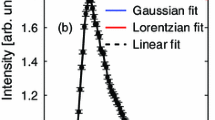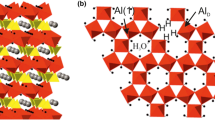Abstract
Samples of nacrite, dickite, kaolinite, and halloysite were investigated using X-band electron paramagnetic resonance (EPR) and Mössbauer spectroscopy. Fe3+ gave rise to EPR signals at g ≃ 4 which differed with the individual polytype. Only nacrite had no resonance in this region of the spectrum, but it had one at g ≃ 2. Dickite had a quadruple line, kaolinite a triple line, and halloysite a single line in this region. The EPR spectra of these minerals are apparently dependent also on the orientation of adjacent layers in the structures. Other resonances were attributed to (1) clusters of ferric ions giving rise to broad resonance near g ≃ 2, (2) trapped holes, and (3) free radicals linked with organic matter. The Mössbauer spectroscopic results suggest that iron occurs in the ferric state (except in nacrite where Fe2+ is present also) as an ionic substitution (IS) in octahedral layers. This suggestion follows from the difference is the IS values between octahedral and tetrahedral symmetry sites occupied by Fe3+ equal to ∼0.4 mm/sec. Linewidths depend mainly on the way the layers stack; for monoclinic modifications represented by nacrite and dickite, the linewidths are narrow (Γ = 0.45 mm/sec and 0.56 mm/sec, respectively); pseudomonoclinic halloysites also gave narrow linewidths (Γ = 0.39 mm/sec and 0.48 mm/sec). The widest line was observed for triclinic kaolinite (Γ = 0.62 mm/sec and 0.71 mm/sec).
Резюме
Образцы накрита, диккита, каолинита, и галлоизита были исследованы при помощи рентгеновских полос электронного парамагнитного резонанса (ЭПР) и спектроскопии Мессбауэра. При g ⋍ 4, Ре3+ вызывали появление ЭПР, разного для индивидуальных политипов. Только накрит не давал резонанса в этой области спектра, но резонанс пояавлялся при g ⋍ 2. Диккит имел четырехкратную, каолинит—тройную, а галлоизит—одиночную линию в этой области. Для этих минералов спектры ЭПР, очевидно, зависят от ориентации соседних слоев в структуре. Другие резонансы были приписаны к: (1) группам ферритовых ионов, вызывающим широкий резонанс в поблизости g ⋍ 2, (2) захватанным дырком, и (3) свободным радикалам, связанным с органической материей. Результаты спектроскопии Мессбауэра указывают на то, что железо встречается в виде феррита (исключая накрит, в котором Ее2+ также присутствует) как ионное замещение (IS) в октаедрических слоях. Это предположение следует из наличия разницы (равной ⋍ 0,4 мм/сек) между величинами IS для октаедрического и тетраедрического мест симметрии, занятых ионами Fе3+. Ширина линии зависит, в основном, от расположения слоев; моноклинная форма накрита и диккита дает узкие линии (Г = 0,45 мм/сек и 0,56 мм/сек, соответственно); псевдомоноклинный галлоизит также дает узкие линии (Г = 0,39 мм/сек и 0,48 мм/сек). Более широкие линии наблюдались для триклинного каолинита (Г = 0,62 мм/сек и 0,71 мм/сек). [Е.С.]
Resümee
Proben von Nakrit, Dickit, Kaolinit, und Halloysit wurden mit Hilfe von elektronenparamagnetischer Resonanz (EPR) und Mössbauerspektroskopie untersucht. Fe3+ verursacht g-Werte von etwa 4, die bei den einzelnen Polytypen verschieden waren. Nur Nakrit hatte keine Resonanz in diesem Bereich des Spektrums dafür aber eine bei g etwa 2. Dickit zeigte in diesem Bereich eine Vierfachlinie, Kaolinit eine Tripellinie, und Halloysit eine einfache Linie. Die EPR-Spektren dieser Minerale hängen offensichtlich auch von der Orientierung der benachbarten Lagen in der Struktur ab. Andere Resonanzen können folgenden Faktoren zugeschrieben werden: (1) Cluster von Fe3+-Ionen verursachen eine breite Resonanz nahe g etwa 2, (2) Haftleerstellen, und (3) freie Radikale, die an organischem Materìal gebunden sind. Die Ergebnisse der Mössbauerspektroskopie deuten darauf hin, daß das Eisen in 3-wertigem Zustand auftritt (mit Ausnahme von Nakrit, bei dem auch Fe2+ vorhanden is) und in ionischer Form in den Oktaederlagen substituiert. Diese Schlußfolgerung ergibt sich aus dem Unterschied von etwa 0,4 mm/sek bei den IS-Werten zwischen den von Fe3+-besetzten Oktaeder- und Tetraederplätzen. Die Linienbreiten hängen hauptsächlich von der Art der Schichtfolge ab; bei monoklinen Modifikationen wie Nakrit und Dickit sind die Linienbreiten klein (Γ = 0,45 mm/sek bzw. 0,56 mm/sek); pseudomonokline Halloysite haben auch eine schmale Linienbreite (Γ = 0,39 mm/sek und 0,48 mm/sek). Die breiteste Linie wurde bei triklinem Kaolinit beobachtet (Γ = 0,62 mm/sek und 0,71 mm/sek). [U.W.]
Résumé
Des échantillons de nacrite, de dickite, de kaolinite, et d’halloysite ont été investigués employant la résonnance paramagnétique à électrons bande-X (EPR) et la spectroscopie de Mössbauer. Fe3+ a donné lieu à des phénomènes EPR à g ≃ 4, différant avec chaque polytype individuel. Seule la nacrite n’avait pas de résonnance dans cette région du spectre, mais elle en avait à g ≃ 2. La dickite avait une ligne quadruple, la kaolinite, une triple ligne, et l’halloysite, une seule ligne dans cette région. Les spectres EPR de ces minéraux sont apparemment aussi dépendants de l’orientation de couches adjacentes dans les structures. D’autres résonnances ont été attribuées à (1) des ensembles d’ions ferriques donnant lieu à une large résonnance près de g ≃ 2, (2) des trous pris au piège, et (3) des radicaux libres liés à, de la matière organique. Les résultats de la spectroscopie de Mössbauer suggèrent que le fer apparait a l’état ferrique (sauf dans la nacrite ou Fe2+ est aussi présent) comme substitution ionique (IS) darts les couches octaèdres. Ces suggestions sont déduites de la différence dans les valeurs IS entre les sites de symmétrie octaèdres et tetraèdres occupés par Fe3+ égal à ≃ 0,4 mm/sec. Les largeurs des lignes dépendaient surtout de la manière dont s’empilaient les couches; pour les modifications monocliniques representées par la nacrite et la dickite, les lignes étaient étroites (Γ = 0,45 mm/sec et 0,56 mm/sec, respectivement); les halloysites pseudomonocliniques donnaient aussi des lignes étroites (Γ = 0,39 mm/sec et 0,48 mm/sec). La ligne la plus large était observée pour la kaolinite triclinique (Γ = 0,62 mm/sec et 0,71 mm/sec). [D.J.]
Similar content being viewed by others
References
Angel, B. R., Cuttler, A. H., Richards, K. S., and Vincent, W. E. J. (1977) Synthetic kaolinites doped with Fe2+ and Fe3+ ions: Clays & Clay Minerals 25, 381–383.
Angel, B. R. and Hall, P. L. (1973) Electron spin resonance studies of kaolinites: in Proc. Int. Clay Conf., Madrid, 1972, J. M. Serratosa, ed., Div. Ciencias C.S.I.C. Madrid, 47–59.
Angel, B. R., Jones, J. P. E., and Hall, P. L. (1974) Electron spin resonance studies of doped synthetic kaolinite I: Clay Miner. 10, 247–255.
Boesman, E. and Schoemaker, D. (1961) Resonance paramagnetic de l’ion Fe3+ dans la kaolinite: C. R. Acad. Sci. 252, 1931–1933.
Castner, T., Newell, G. S., Holton, W. C., and Slichter, C. P. (1960) Note on the paramagnetic resonance of iron in glass: J. Chem. Phys. 32, 668–673.
Friedlander, H. Z., Frink, C. R., and Saldick, J. (1963) Electron spin resonance spectra in various clay minerals: Nature 199, 61–62.
Giese, R. F. and Datta, P. (1973) Hydroxyl orientation in kaolinite, dickite and nacrite: Amer. Miner. 58, 471–479.
Hinckley, D. N. (1963) Variability in “crystallinity” values among the kaolin deposits of the coastal plain of Georgia and South Carolina: in Clays and Clay Minerals, Proc. 10th Natl. Conf., Austin, Texas, 1961, Ada Swineford and P. C. Franks, eds., Pergamon Press, New York, 229–235.
Jefferson, D. A., Tricker, M. J., and Winterbottom, A. P. (1975) Electron microscopic and Mössbauer spectroscopic studies of iron-stained kaolinite minerals: Clays & Clay Minerals 23, 355–360.
Jones, J. P. E., Angel, B. R., and Hall, P. L. (1974) Electron spin resonance studies of doped synthetic kaolinites. II: Clay Miner. 10, 257–270.
Kvashnina, L. B. and Krivoglaz, M. A. (1967) Mossbauer spectra in crystal with defects: Fiz. Metal. Metaloved. 23, 3–14 (in Russian).
Maiden, P. J. and Meads, R. E. (1967) Substitution by iron in kaolinite: Nature 215, 844–846.
Meads, R. E. and Maiden, P. J. (1975) Electron spin resonance in natural kaolinites containing Fe3+ and other transition metal ions: Clay Miner. 10, 313–345.
Mehra, O. P. and Jackson, M. L. (1960) Iron oxide removal from soils and clays by a dithionite citrate system buffered with sodium bicarbonate: in Clays and Clay Minerals, Proc. 7th Natl. Conf., Washington, D.C., 1958, Ada Swineford, ed., Pergamon Press, New York, 317–327.
Searl, J. W., Smith, R. C., and Wyard, S. J. (1959) Electron spin resonance absorption for polycrystalline substances: Proc. Phys. Soc. 74, 491–493.
Stoch, L. (1974) Clay Minerals: Ed. Wyd. Geologiczne Warszawa, 191 pp. (in Polish).
Zvyagin, B. B. (1967) Electron-Diffraction Analysis of Clay Mineral Structure: Pergamon Press, New York, 364 pp.
Author information
Authors and Affiliations
Rights and permissions
About this article
Cite this article
Komusiński, J., Stoch, L. & Dubiel, S.M. Application of Electron Paramagnetic Resonance and Mössbauer Spectroscopy in the Investigation of Kaolinite-Group Minerals. Clays Clay Miner. 29, 23–30 (1981). https://doi.org/10.1346/CCMN.1981.0290104
Received:
Accepted:
Published:
Issue Date:
DOI: https://doi.org/10.1346/CCMN.1981.0290104




